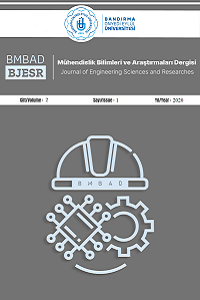Öz
Bu çalışmada, günümüzde yaygın
olarak kullanılan alternatif enerji kaynaklarından olan güneş enerjisinden
elektrik üretiminde kullanılan fotovoltaik panellerin modellenmesi
gerçekleştirilmiştir. Bir fotovoltaik paneli oluşturan fotovoltaik hücrelerin tek
diyotlu modeli kullanılarak fotovoltaik panel ve dizinin modeli elde edilmiştir.
İlk olarak fotovoltaik hücrenin tek diyotlu modellenmesi yapılmıştır. Bu
modelde panel üzerinde kullanılan hücre sayısı değeri kullanılarak panel modeli
ve panellerin seri/paralel bağlanması ile sistemdeki enerji kaynağını oluşturan
fotovoltaik dizinin modeli elde edilmiştir. Çalışmada toplam altı adet 1Soltech
1STH-215-P model panelin bulunduğu dizi modellemesi gerçekleştirilmiştir. Modelde
üç adet seri bağlı panel olan iki paralel kol bulunmaktadır. Sunulan modelin
farklı sıcaklık ve ışınım değerlerinde elektriksel çalışma eğrileri elde
edilmiştir. Aynı panel dizisi Matlab/Simulink yazılımında bulunan fotovoltaik
panel bloğu ile çalıştırılmış ve sonuçlar karşılaştırılmıştır. İki farklı
modelden üretilen çalışma karakteristikleri incelendiğinde birbirleri ile
oldukça yakın sonuçlar elde edildiği görülmüştür. Elde edilen sonuçlar sunulan
modelin fotovoltaik sistem tasarımında enerji hesabı, genel sistem simülasyonu
gibi ön çalışmalarda kullanılabilir olduğunu göstermiştir.
Anahtar Kelimeler
Kaynakça
- [1] F. A. Omar, G. Gökkuş ve A. A. Kulaksız, “Şebekeden bağımsız FV sistemde maksimum güç noktası takip algoritmalarının değişken hava şartları altında karşılaştırmalı analizi”, Konya Mühendislik Bilimleri Dergisi, vol. 7, no. 3, pp. 585-594, 2019.
- [2] X. Li, Q. Wang, H. Wen and W. Xiao, “Comprehensive studies on operational principles for maximum power point tracking in photovoltaic systems”, IEEE Access Special Section on Emerging Technologies for Energy Internet, vol. 7, pp. 121407-121420, 2019.
- [3] N. M. A. A. Shannan, N. Z. Yahaya and B. Singh, “Single-diode model and two-diode model of PV modules: a comparison”, 2013 IEEE International Conference on Control system, Computing and Engineering, pp. 210-214, 2013.
- [4] A. K. Podder, N. K. Roy and H. R. Pota, “MPPT methods for solar PV systems: a critical review based on tracking nature”, IET Renewable Power Generation, vol. 13, no. 10, pp. 1615-1632, 2019.
- [5] N. S. Cetin, E. Deniz and K. Basaran, Fotovoltaik uygulamalar için alternatif akım tarafında maksimum güç noktası takibi”, Afyon Kocatepe Üniversitesi Fen ve Mühendislik Bilimleri Dergisi, vol. 18, no. 2, pp. 495-503, 2018.
- [6] S. Duman, N. Yörükeren ve İ. H. Altaş, “Fotovoltaik enerji sistemlerinin modellenmesi, benzetimi ve uygulaması”, İleri Teknoloji Bilimleri Dergisi, vol. 3, no. 1, pp. 9-23, 2014.
- [7] G. Bayrak ve Mehmet Cebeci, “3.6 kW gücündeki fotovoltaik generatörün matlab simulink ile modellenmesi”, Erciyes University Journal of the Institute of Science and Teknoloji, vol. 28, no. 3, pp. 198-204, 2012.
- [8] F. Bradaschia, M. C. Cavalcanti, A. J. Nascimento, E. A. Silva and G. M. S. Azevedo, “Parameter identification for PV modules based on an enviroment-dependent double-diode model”, IEEE Journal of Photovoltaics, vol. 9, no. 5, pp. 1388-1397, 2019.
- [9] R. Elgohary, A. A. A. Elela and A. Elkholy, “Electrical characteristic modeling for photovoltaic modules based on single and two diode models”, 2018 Twentieth International Middle East Power Systems Conference (MEPCON), pp. 685-688, 2018.
- [10] A. A. Chauhan and B. S. Prakash, “Considering various equivalent circuits for solar PV array modelling”, 2018 2nd International Conference on Power, Energy and Environment: Towards Smart Technology (ICEPE), pp. 1-6, 2018.
- [11] C. Qi and Z. Ming, “Photovoltaic module simulink model for a stand-alone PV system ”, 2012 International Conference on Applied Physics and Industrial Engineering, pp. 94-100, 2012.
- [12] H. Bellia, R. Youcef and M. Fatima, “A detailed modeling of photovoltaic module using MATLAB”, NRIAG Journal of Astronomy and Geophysics, vol. 3, no. 1, pp. 53-61, 2014.
- [13] B. A. Aldwihi, M. Salihmuhsin, “Modeling of photovoltaic panels using Matlab/Simulink”, Kahramanmaras Sutcu Imam University Journal of Engineering Sciences, vol. 22, no. 2, pp. 78-87, 2019.
Ayrıntılar
| Birincil Dil | Türkçe |
|---|---|
| Konular | Elektrik Mühendisliği |
| Bölüm | Araştırma Makaleleri |
| Yazarlar | |
| Yayımlanma Tarihi | 29 Nisan 2020 |
| Yayımlandığı Sayı | Yıl 2020 Cilt: 2 Sayı: 1 |


